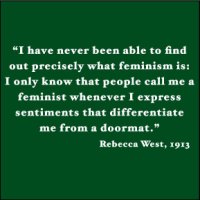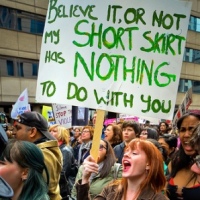 The recent Sunday Telegraph campaign against graphic artist Robert Crumb’s proposed participation in an exhibition at the Sydney Opera House, used the opinions of anti child abuse campaigner Hetty Johnson to infer that Crumb’s work is complicit in creating communities that are unsafe for children and should be banned.
The recent Sunday Telegraph campaign against graphic artist Robert Crumb’s proposed participation in an exhibition at the Sydney Opera House, used the opinions of anti child abuse campaigner Hetty Johnson to infer that Crumb’s work is complicit in creating communities that are unsafe for children and should be banned.
The Tele apparently faxed Ms Johnson (who had previously never heard of the artist) a few copies of Crumb’s cartoons, leading her to decide that: ”the Sydney Opera House is endorsing the depraved thought processes of this very warped human being. These cartoons are not funny or artistic – they are just crude and perverted images emanating from what is clearly a sick mind.”
Crumb cancelled his trip, giving reasons in this open letter to the Sydney Morning Herald.
Anti child abuse campaigners like Ms Johnson have an important role to play in any community. Children must not be abused. We must do everything we can to address child abuse of every kind wherever we find it, because we are cruel and inhuman if we don’t.
But it’s a symptom of psychosis to mistake illusion for reality. Campaigners such as Ms Johnson are striving to impose a psychotic world view when they campaign against images such as those produced by Crumb, and closer to home, Bill Henson. Such campaigners necessarily view the world around them through the eyes of those who are sexually aroused by children. They seek in images of all kinds what they imagine paedophiles desire. They assume these images will provoke undesirable action in their viewers. They have no basis for these assumptions. They have no evidence. They simply object.
After working for many years with survivors of childhood sexual assault, I can attest that one can eventually see suspicious behaviour everywhere, in the most innocent of gestures, and on reaching that point a sensible practitioner knows it’s time to take a break. Yes, there are adults who abuse children. No, it’s not everybody. Yes there are images that paedophiles seek out and exchange. No, they are not every image in art or advertising that feature children.
These efforts by campaigners to colonise the public gaze have nothing whatsoever to do with preventing child abuse. Children are overwhelmingly sexually abused by people they know, frequently close family members. They are not necessarily abused by sexually crazed admirers of Robert Crumb and Bill Henson, or even by those sad human beings who earn their livelihood designing “sexy” underwear for little girls, and the even sadder mothers who buy it for them.
Here, I have to say that I don’t find the linked advertisements guilty of “sexualizing” the young models. I believe we need a conversation about what is and isn’t sexy and to whom, because it seems to me that campaigners are adopting a definition of “sexy” that is not necessarily shared by the whole community.
I find these images of the girls silly and sad. There’s not one thing that’s “sexy”about them. They are degrading not because they sexualize, but because they commodify. The young girls’ beauty is not sexualized, it is ruthlessly co-opted and exploited to sell product. The girls are dehumanized because of this, as are we all to varying degrees by the capitalist society in which we live.
It’s also worthy of note that these campaigners cannot, apparently, achieve their goals without perpetuating and trafficking in the “offensive” images. So on websites such as that belonging to Melinda Tankard Reist you will find links to purported “evidence” of the “sexualization” of young girls, sometimes tantalizingly prefaced by comments such as “if you can bear to look.” Unless you are willing to take Reist’s word for it, you have to open the links.
Without public outrage, these campaigners will cease to exist. They have everything invested in encouraging the viewing and sharing of the images they condemn. The question must be asked, are they too engaged in the process of commodification and exploitation of the child models? Is this the underlying reason why they are unable to address these matters as corporate and consumer issues?
What campaigners such as Hetty Johnson and Tankard Reist are actually engaged in are diversionary tactics. In blaming the art they do not understand for creating a climate in which the so-called “sexualization” of children is promoted and nurtured, they are distracting attention from the real culprits: corporations and consumers. Human beings have long been reduced to the status of a commodity in the interests of profit. Greed, not paedophilia underpins the increasing sexualization of children. The personal worth of adults has long been measured by their exchange value: it was only a matter of time before this extended itself to the imposition on children of impoverished and crude adult notions of what is “sexy,” designed purely to extend the profitability of human exploitation and commodification.
 Back to Robert Crumb. Crumb’s work is a fine example of the power of catharsis. The artist owns himself as “weird,” highly anxious and neurotic, and possessing a vividly boisterous sexual imagination. These characteristics imbue his work with powerful feeling, and viewing Crumb’s images is often a disturbing experience.
Back to Robert Crumb. Crumb’s work is a fine example of the power of catharsis. The artist owns himself as “weird,” highly anxious and neurotic, and possessing a vividly boisterous sexual imagination. These characteristics imbue his work with powerful feeling, and viewing Crumb’s images is often a disturbing experience.
But remember: “Art is dangerous,” Picasso claimed. “Art is never chaste. Where it is chaste, it is not art.”
The artist’s job is often to expose to the rest of us what we might not want to see or acknowledge as human. The best artists won’t flinch in their task of expressing what we would most like to deny about humanity. Those who are too afraid to rise to the artist’s challenge will demand censorship. They will clamour for the silencing of the artist’s imagination because, they claim, there is an inherent link between the imagination, and the acting out of imaginative visions. In other words, they take Picasso’s claim that art is dangerous far too literally.
Art is dangerous to the closed mind. Art can take us to emotional experiences and spiritual realisations that are not always easy and comfortable. But art will not turn us into paedophiles. The horrifying photographic images of sexually exploited and tormented children passed around a paedophile ring are not art.
While the artist may be expressing a personal vision, the fact that others can identify with and appreciate the artwork transforms the personal into the universal. Finding imaginative ways in which to safely express the darker and more dangerous emotions is the cathartic experience, and the cathartic experience is one that can enable a safe release of unconscious conflicts in the viewer as well as the artist. This is the power of art, and I include in the category of “art” all mediums of expression. Dark and dangerous emotions are human. They demand acknowledgement and safe expression. Art offers safe emotional release, both in its making and its appreciation.
This is the experience campaigners such as Johnson and Tankard-Reist wish to deny us. Trapped in a spiral of denial, they need to universalize their positions in order to feel validated. They need us all to agree with their critical judgements. They demand that we all adopt the paedophile’s gaze, and interpret the art that surrounds us, whatever its form, through that lens. They do not discriminate, their responses are formulaic and tiresome: if it is weird and sick to them, it has to be weird and sick to everyone, and the weird and sick must be silenced and denied.
What currently passes for “sexy” in our culture seems to me to be highly unsubtle, crude and largely uninteresting. Yet these campaigners have somehow managed to turn this one-dimensional representation of human sexuality into a cultural threat of nuclear proportions, especially for our children. Artists such as Crumb and Henson, of all people, have been caught up in this manufactured threat.
Campaigners themselves insist on reproducing many of the very images they decry, because, they claim, people must see them in order to be able to protest them. Outrage is their weapon of choice, and they must create enough of it to bring about their censorship goals.
Yet all they ever achieve is a band-aid solution. They do not address the underlying issues. They do not go deeply into the immorality of the increasing commodification of the human. They do not address a global economy that survives only as long as we all consume as much as is possible for as long as we are alive, making the construction of new markets an absolute necessity, even when that market is children and childhood. They do not address the complicity and collusion of mothers and caregivers in the sexualization and commodification of children and childhood. They do attack art, in all its forms, because that is easy.
The conflation of the “sexualization” of children and paedophilia with the perceived dangers of art needs to be challenged and resisted whenever it rears its hydra-head. The real role of anti child abuse campaigners is to work for educative and economic services that will help protect children, and that will offer accessible services for adults recovering from the frequently life long aftermath of childhood abuse.
There is no place for these campaigners as arbiters in the world of art. They have proved over and over again that their perspective is warped and one-dimensional, and that censorship is their only response to expressions of the human that they do not understand.
Tags: Bill Henson, Child abuse, Hetty Johnson, Melinda Tankard Reist, Pedophilia, Robert Crumb, Sexual abuse

 The recent Sunday Telegraph
The recent Sunday Telegraph  Back to Robert Crumb. Crumb’s work is a fine example of the power of catharsis. The artist owns himself as “weird,” highly anxious and neurotic, and possessing a vividly boisterous sexual imagination. These characteristics imbue his work with powerful feeling, and viewing Crumb’s images is often a disturbing experience.
Back to Robert Crumb. Crumb’s work is a fine example of the power of catharsis. The artist owns himself as “weird,” highly anxious and neurotic, and possessing a vividly boisterous sexual imagination. These characteristics imbue his work with powerful feeling, and viewing Crumb’s images is often a disturbing experience.



































Recent Comments